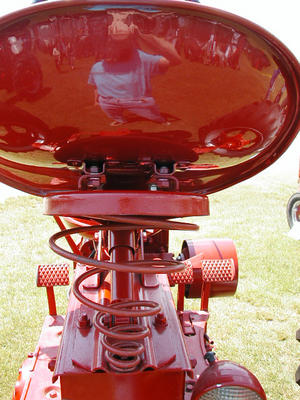
Last weekend my husband and I went to Kent, CT to the CT Antique Machinery Association show. It is a pleasant ride on a nice day and the show is always fun...even when you don't find anything you are looking for to buy. The association is putting a great deal of volunteer time and money into buildings to house their awesome collection of things that go whirrr, thump, putt-putt, and clank. And I don't want to slight those things that go hiss, toot and clickety-clack! In addition they now have a fascinatingly eccentric museum of minerals of Connecticut and our brick making heritage.

For those of you who prefer plants to machines, you might want to go to Bartholomew's Cobble which is on the way to Kent if you are coming from Stock bridge MA. Look it up on the web to see why. Speaking of plants, the reason I started writing this morning was to show you a picture of what I did buy that day. You can see them hanging by the oars (part of my bow facing oar collection).
Commonly called Chinese Lantern plant, the photo shows Physalis alkekengi, which is a perennial herb of the nightshade family, Solanaceae. It is native to southeastern Europe and Asia. Go to http://2bnthewild.com/plants/H56.htm to read about our native species of Physalis.
For gardeners:
I checked out the name of the Chinese Lantern before I wrote this morning and found this scary story in the Garden Web forum. We have all had some sort of experience with what I call thug plants (mine was with Oriental Bittersweet which I was told was not invasive, with a native helianthus, with pachysandra, with...)
"Last fall around this very time I planted about 30 Chinese Lantern seedlings in a bed on my front lawn. The bed is edged with a good quality black edging about 4-5" deep and with a heavy rim. This year the lanterns matured and I have dried them but due to a warning by a fellow "Garden Webber" I dug down under the soil to see what was going on and the Chinese Lanterns had spread runner roots all over my entire bed (10' x 8') in a woven mat type scenario. I was devastated! The runners are even going into my lawn and heading for my neighbor's lawn as well. I've yanked out all the plants and have, not once, but THREE TIMES turned the soil and removed runners anywhere from 3-8 feet long. This plant is a nightmare. Not even one full year in the ground and only bloomed once but it has taken over 80 square feet of my property (maybe more). The runners that I can't get at have entwined themselves under my tree and shrub roots. I will turn the soil one more time and attempt to take out as much as I can but this has been excruciatingly labor intensive as I'm doing the turning with my hands instead of a shovel that can break the roots apart and create all new plants. After that I will just leave it and when sprouts come up in the spring I will paint roundup onto the leaves to hopefully kill the rest of the roots systemically. If I ever grow this plant again it will be IN POTS ON MY DECK where it can't go crazy like this. At any rate, I want to tell the people who warned me about these plants a BIG THANK YOU for telling me to get them out of my front bed. I can't even imagine what the situation would have been like another year down the road. Impossible, I'm sure. So if you are thinking of planting Chinese Lanterns in one of your beds, re-think it as this plant seems to be good for nothing but crafts and erosion control when planted in the ground. I did dry the lanterns I got this year before ripping out the plants and roots and they will dry nicely for some autumn decoration but that's it for me, for now, for a while....
Regards,
Barb
southern Ontario, CANADA"
No comments:
Post a Comment